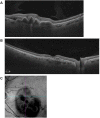Polypoidal Choroidal Vasculopathy: An Update on Diagnosis and Treatment
- PMID: 36636621
- PMCID: PMC9831529
- DOI: 10.2147/OPTH.S385827
Polypoidal Choroidal Vasculopathy: An Update on Diagnosis and Treatment
Abstract
Polypoidal choroidal vasculopathy (PCV) is a vascular disease of the choroid that leads to hemorrhagic and exudative macular degeneration. It may cause significant vision loss and thus affect the quality-of-life and psychological well-being. Non-invasive, non-ICGA-based OCT criteria have shown reliable results to plan adjunct photodynamic therapy (PDT) treatment, with the complete and consistent coverage of polypoidal lesions (PL) and branching neovascular network (BNN). The safety and efficacy of anti-vascular endothelial growth factor (anti-VEGF) monotherapy and its combination with verteporfin PDT have been established. However, treatment is still challenging due to frequent follow-ups, non-availability of PDT, and need for multiple anti-VEGF injection visits that increase the treatment burden and lead to patients being lost to follow-up. Effective treatments that prolong intervals between injections while maintaining vision and anatomical gains remain a critical unmet need. Longer acting molecules, like brolucizumab, have shown non-inferiority in BCVA gains and superior anatomical outcomes compared to other anti-VEGF agents. Newer therapies in the pipeline to enhance the efficacy and longevity of treatment include Faricimab and a port delivery system (PDS). This review summarizes the most recent diagnostic and treatment approaches in PCV to offer better treatment avenues.
Keywords: anti-vascular endothelial growth factor (anti-VEGF) agents; best-corrected visual acuity; branching neovascular network; brolucizumab; photodynamic therapy; polypoidal lesions.
© 2023 Sen et al.
Conflict of interest statement
Vineeth Salloju and Priyanka Dhar are employees of Novartis Healthcare Private Limited, India. The authors report no other conflicts of interest in this work.
Figures









Similar articles
-
Non-ICGA treatment criteria for Suboptimal Anti-VEGF Response for Polypoidal Choroidal Vasculopathy: APOIS PCV Workgroup Report 2.Ophthalmol Retina. 2021 Oct;5(10):945-953. doi: 10.1016/j.oret.2021.04.002. Epub 2021 Apr 16. Ophthalmol Retina. 2021. PMID: 33866022
-
Photodynamic therapy for polypoidal choroidal vasculopathy.Prog Retin Eye Res. 2013 Nov;37:182-99. doi: 10.1016/j.preteyeres.2013.09.003. Epub 2013 Oct 15. Prog Retin Eye Res. 2013. PMID: 24140257 Review.
-
Long-term efficacy and safety of verteporfin photodynamic therapy in combination with anti-vascular endothelial growth factor for polypoidal choroidal vasculopathy.Indian J Ophthalmol. 2018 Aug;66(8):1119-1127. doi: 10.4103/ijo.IJO_1222_17. Indian J Ophthalmol. 2018. PMID: 30038155 Free PMC article.
-
Timing of Complete Polypoidal Regression after Intravitreous Aflibercept Treatments in Polypoidal Choroidal Vasculopathy.Ophthalmol Retina. 2022 Jan;6(1):21-28. doi: 10.1016/j.oret.2021.03.012. Epub 2021 Mar 27. Ophthalmol Retina. 2022. PMID: 33781929
-
[Polypoidal choroidal vasculopathy].Nippon Ganka Gakkai Zasshi. 2012 Mar;116(3):200-31; discussion 232. doi: 10.4264/numa.71.282. Nippon Ganka Gakkai Zasshi. 2012. PMID: 22568102 Review. Japanese.
Cited by
-
Detection and Elimination of Senescent Cells with a Self-Assembled Senescence-Associated β-Galactosidase-Activatable Nanophotosensitizer.J Med Chem. 2024 Jan 11;67(1):234-244. doi: 10.1021/acs.jmedchem.3c01306. Epub 2023 Dec 19. J Med Chem. 2024. PMID: 38113190 Free PMC article.
-
Development and validation of optical coherence tomography (OCT) and OCT angiography prediction model for short-term vitreous haemorrhage secondary to polypoidal choroidal vasculopathy.Br J Ophthalmol. 2025 Feb 24;109(3):391-400. doi: 10.1136/bjo-2024-325246. Br J Ophthalmol. 2025. PMID: 39181543 Free PMC article.
-
Blue Light and Green Light Fundus Autofluorescence, Complementary to Optical Coherence Tomography, in Age-Related Macular Degeneration Evaluation.Diagnostics (Basel). 2025 Jul 2;15(13):1688. doi: 10.3390/diagnostics15131688. Diagnostics (Basel). 2025. PMID: 40647687 Free PMC article. Review.
-
Comparative efficacy of conbercept 3+PRN versus 3+TAE regimens for the treatment of polypoidal choroidal vasculopathy.Int Ophthalmol. 2025 Apr 1;45(1):139. doi: 10.1007/s10792-025-03481-x. Int Ophthalmol. 2025. PMID: 40167859
-
Switching to Faricimab for Polypoidal Choroidal Vasculopathy with Real-World Outcomes in Refractory Cases - The FAR-PEARL Study Report 1.Clin Ophthalmol. 2025 Jul 28;19:2475-2485. doi: 10.2147/OPTH.S527787. eCollection 2025. Clin Ophthalmol. 2025. PMID: 40757168 Free PMC article.
References
Publication types
LinkOut - more resources
Full Text Sources
Miscellaneous

